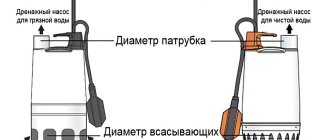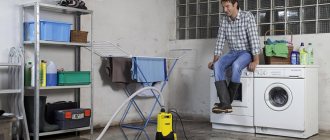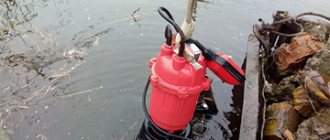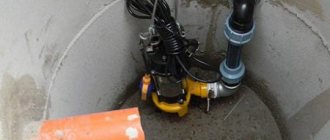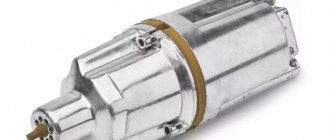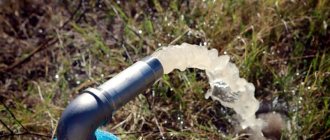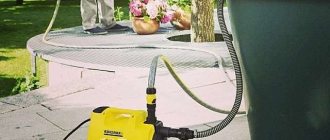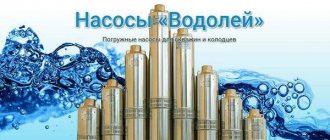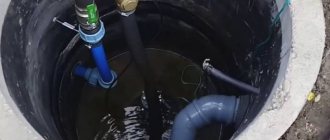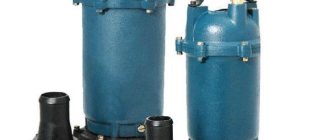Scope of application
Drainage pumps for dachas are indispensable equipment. They can be used to drain tanks, remove liquid from a well before inspection or repair, and even in an irrigation system from tanks or a natural reservoir, if the fluid parameters meet the requirements specified in the operating instructions.
A drain pump will be useful:
- when the groundwater level rises,
- during a flood,
- for draining basements and cellars,
- to eliminate the consequences of highway breaks,
- to clean up the area after heavy rainfall,
- for maintenance of artificial ponds and swimming pools,
- for supplying water to fountains,
- for organizing drip irrigation over large areas.
Pumping dirty water with a drainage pump is also possible from a small pit
Rules for operating the pump when cleaning a well
When choosing a device for cleaning a well, carefully read the instructions for the model you like. You need to listen to the rules:
- Remember that there are devices capable of pumping only clean water, without foreign impurities.
- If you supply dirty water to them, this will lead to rapid breakdown.
- To clean a silted mine, you will need drainage pumps that can pump dirty water containing impurities and small fractions of solid particles.
The service life and quality of water pumping will depend on the correct operation of the product.
Types of drainage pumps
All drainage pumps for pumping water from wells can be divided into categories according to various parameters. For example, based on the type of installation, surface and submersible models are distinguished.
A submersible drainage pump for a well is placed in the water column. It is placed there using a cable and fixed at a certain depth (usually 50-100 cm from the bottom).
The advantages of such designs are:
- small size and weight of models compared to surface models with equal operational capabilities,
- ability to work properly for a long time without maintenance,
- a wide range of possibilities regarding the degree of contamination of the transported liquid (a drainage pump for cleaning a well can pump lightly and heavily contaminated water),
- good productivity (up to 40 cubic meters per hour),
- simplicity and ease of use due to the presence of float protection and the ability to connect the unit to automatic systems.
Disadvantages of submersible models:
- low (compared to surface units) pressure, especially with a large source depth,
- inability to filter water during pumping.
Important: Submersible drainage pumps for wells can be centrifugal or vibration. The former are more productive, and the latter have a lower cost.
Submersible drainage pump with float protection
If you are looking for a drainage pump for a well, you can only understand how to choose a suitable unit by studying the features of all types.
The use of surface models has its own nuances.
Their advantages include:
- good pressure, allowing horizontal transportation over long distances,
- longer (compared to submersible models) service life due to more comfortable operating conditions for the equipment,
- lower price,
- economical operation due to low energy consumption.
Surface drainage pumps can also be used for irrigation from a well.
Disadvantages of surface units:
- small suction depth - up to 8 m (surface pumps can only operate in shallow wells),
- high noise level during operation.
Submersible centrifugal pumps
Submersible well pumps with a centrifugal mechanism are made in the form of a sealed cylinder, usually made of stainless steel, sometimes made of plastic. The suction pipe is located at the bottom of the housing, and the motor is located at the top.
It is important that such a unit is completely immersed in water during operation, otherwise the engine will not cool, which will lead to overheating and failure. Various devices are used to regulate the water level, but the most reliable is a well pump with a conventional float.
Submersible centrifugal pumps for wells
Advantages:
- Pump immersion depth up to several tens of meters;
- Pressure up to 60 meters;
- Performance varies widely depending on the model, which makes it possible to choose exactly the one that suits your needs.
Flaws:
- Connecting the pump requires proper installation of power supply to the well;
- The cost of such units is an order of magnitude higher than surface units;
- In cases of improper operation, there is a possibility of pump failure, chamber depressurization and oil spill. An oil stain from the surface of the water is difficult to remove; a complete cleaning of the shaft is usually required.
Selection criteria and rules
Before choosing a unit, you should make some measurements and calculations.
- The depth of the well is most easily determined using twine or a cord with a weight.
- Using a regular tape measure, you can measure the diameter of the shaft or the length of its side if your well has a square shaft.
These two values will help you determine the total volume of water that needs to be pumped out when cleaning the well with a sump pump. In some cases, when carrying out calculations, an adjustment is made for the level of the water surface, since water does not completely fill the shaft.
The degree of water pollution can be assessed visually
In this case, water quality can be determined visually, without any research. It is enough just to estimate the amount of impurities and their linear dimensions . Acceptable parameters are indicated in the instructions for the pump, and they must correspond to the quality of the water.
Working conditions are another important factor. For seasonal or periodic operation, portable models can be used, and permanently installed units are recommended to be emptied of water and preserved during a long break in operation. Year-round use of a surface pumping unit imposes special requirements: in this case, the pump must be located in a heated or thermally insulated room to avoid freezing of the system.
The most accurate selection of a model can be made if you take into account the nuances of the “behavior” of water in a well - maximum and minimum levels, average position, source flow (intensity of liquid arrival).
Basic patterns of choice:
- For shallow sources or for collecting liquid from the upper part of the water column, it is recommended to choose surface models; for deep mines, submersible modifications are preferred.
- Overheating and dry-running protection systems will not only extend the life of the pumping unit, but also increase the safety of the system as a whole.
Calculation of pressure and productivity
Pressure and performance are the main characteristics of drainage pumps. To accurately select a model, you need to know the algorithm for calculating these parameters.
- Unit performance is the volume of pumped liquid per unit of time. The required capacity is selected independently, taking into account the total volume of water in the source and the time during which this volume must be pumped out. The optimal duration of pumping without stopping is usually indicated in the accompanying documentation.
- Pressure characteristics are determined as the sum of the depth of water intake and the length of horizontal movement of the liquid to the discharge point, divided by 10.
Design nuances
When choosing a pump for cleaning a well, pay attention to its design features.
- The suction hole located in the lower part will ensure the most complete removal of liquid from the shaft.
- Cast iron casings are reliable, but they are heavy; lightweight plastic casings are not strong enough; a steel casing is the best option.
- The size of the working chamber determines the permissible size of inclusions.
- The simpler the design of the pumping unit, the less often it will break down and the easier it will be to repair it.
Submersible vibration pumps
This type of device is more often used at the dacha “in season” for watering the garden and arranging water supply on the site. Advantages:
- Relatively low cost;
- Easy installation and operation;
- The pressure may vary depending on the model, the maximum is within 60 meters;
Submersible Vibration Pump
Disadvantages
- Low performance;
- Such units cannot be used for wells that are built on quicksand.
Advice! The most practical option for a well would be a pump that, in addition to supplying clean water, can also pump out dirty water, for example, when it is necessary to clean the mine or draw water from another source.
Work technique
It is important not only to choose the right mud pump for cleaning wells, but also to install it without any violations, and also to use it correctly.
Installation procedure
- The suction pipe of the pump is connected to the pressure line.
- If the pumping unit will be installed permanently and is equipped with a float protection, it is advisable to install an additional check valve.
- Before connecting the pump to a three-phase network, it is important to check the direction of rotation of the motor.
Installation diagram of a submersible drainage pump
Checking the direction of rotation is carried out as follows: the pump installed on a flat surface is turned on and quickly turned off. Determine the direction of rotation of the shaft and draw conclusions:
- clockwise rotation indicates correct connection,
- if the shaft rotates in the opposite direction, the phases are reversed.
If the unit is already connected to the pipeline, the algorithm changes:
- turn on the pump and measure operating parameters and pressure power.
- after disconnecting, swap the phases and repeat the testing.
The correct connection is the one at which the performance is higher.
Well cleaning
Removing contaminated water from a well using a submersible pump is carried out in a certain sequence.
Cleaning a well with a submersible pump
- The unit is installed in accordance with the instructions and turned on (the required distance from the bottom is maintained), and its outlet pipe supplies the pumped water back to the well.
- With this process, the intense movement of liquid flows will contribute to the destruction of bottom silt deposits, which will then be retained on the pump filter.
- The continuous operation time of the unit is determined by the capabilities of the models, but in any case, the pump must be turned off and cleaned every few hours.
- The cycles are repeated until the pumped water becomes clean and the pump filter no longer becomes dirty.
We talked in more detail about the surface pump for dirty water in a separate article.
Speaking about how to clean a well with your own hands, you should note other methods that are also effective.
Read about installing a country water supply from a well here.
Nuances of use
To increase the efficiency of cleaning a well using a drainage pump, you should also take into account some nuances.
- If the mine is heavily polluted (the well has not been cleaned for a long time, a lot of sediment has formed), it is better to use fecal pumps rather than drainage pumps.
- The required drain pump power depends on the cleaning frequency. If you often “pump” water preventively, a small power is enough; if you prefer rare major cleanings, it is better to choose a pumping unit with a higher power.
Many users prefer to clean the well with powerful pumps once every 1 or 2 years. It should only be taken into account that the washing time under such conditions will be about one week. Upon completion of work, the pump must be removed, drained of water and stored in a dry room until next use.
This video will help you in choosing a drainage pump for cleaning a well or for other purposes.
Review of pumps from trusted manufacturers
The buyer who owns an estate with a well is offered an extensive range of reliable pumping equipment supplied by domestic and foreign manufacturing companies.
Decent offers from foreign brands
Let us list the popular foreign brands of pumps that are in demand among summer residents and lovers of country life:
- ESPA, Spain . The products of the manufacturer Espa Group are distinguished by stable operation, endurance, and maximum adaptability to operation in difficult Russian conditions. The company's activities started with the production of centrifugal pumping systems more than half a century ago. Now the company offers a series of submersible well pumps and surface stations for domestic use. Price tag from 9 thousand rubles.
- PEDROLLO, Italy . For more than 20 years, it has been supplying deep well pumps and self-priming surface units to the domestic market. The company's products are attractive due to their lightness, which is successfully combined with the strength of the parts and housing; anti-corrosion materials that meet high environmental requirements are used in production. Price from 14 thousand rubles.
- KARCHER or KG for short, Germany . It has been producing pumps for over 80 years; the line of pumping equipment for wells includes submersible pumps and water supply stations with automation and a hydraulic tank. KG pump technology is characterized by perfect assembly precision and long service life. Price from 9 thousand rubles.
- GARDENA, Germany . The company specializes in the production of garden tools and equipment. It produces garden pumps for collecting water from shallow excavations and open reservoirs, borehole pumping equipment and automatic pressure stations. The price of the units depends on the design complexity, starts from 6 thousand rubles, the average price tag is 13 – 23 thousand rubles.
- GRUNDFOS, Denmark . The largest manufacturer of pumping equipment, whose products are respected for their wear resistance and high degree of corrosion protection. Submersible and surface Danish pumping machines are justifiably popular, the average price is 27 thousand rubles.
- ZDS, Italy . It produces premium pumping equipment; the company is famous for its unique system of protecting engines from overheating, dry running, and power surges. The product line for wells includes high-performance items capable of pumping water with some sand content. Average price tag from 32 thousand rubles.
The wide foreign selection is somewhat overshadowed by the impressive cost of serious models. Moreover, pumps for collecting perched water can be purchased at a very reasonable price.
Significant disadvantages include the high cost of repairs and the difficulty of delivering original spare parts to replace worn-out ones that have not withstood the hardships of local operation.
Despite the extensive model range, foreign-made pumps have significant drawbacks: complications with repairs and delivery of original spare parts
Details about domestically produced pumps
The disadvantages of foreign units spontaneously turn into advantages of domestic products. The buyer of a pump with a Russian brand will not be intimidated by the price, nor will they be bothered by the difficulties of repair. A pleasant bonus will be a convincing one-year warranty, as well as the ability to quickly exchange your purchase for a more suitable model.
Kid: small and smart!
Many generations of summer residents are familiar with the hard work and unpretentiousness of the Malysh household pump. The products are manufactured by OJSC HMS Livgidromash, located in the Vladimir region. Over more than 70 years of development, the only representative gave rise to numerous modifications.
The product line includes models with variations in pressure and intake depth; there are options with a suction pipe located at the bottom or at the top.
Purchase with a lower connection if you are transporting impeccably clean water. They are purchased with an upper pipe if there is a risk of clogging with silt and other suspended impurities.
The legendary Malysh pump is one of the most inexpensive and unpretentious pumps, providing horizontal water supply over a distance of over 100 meters (+)
The universal unit is suitable for extracting water from wells, open reservoirs, and boreholes. This is not the most suitable type for equipping a constantly functioning water supply system.
However, among equally compact machines, it leads in performance parameters. Resistant to power surges, tolerant of shortcomings in the electrical network, and protected from dry running.
The vibration unit Malysh attracts with its simplicity of design and attractive price. On average, the cost of miniature equipment ranges from 1.5 to just over 2 thousand rubles. The analogue is the Rucheek pump, which is practically no different from the Malysh in technical and price aspects.
Rucheek and Malysh pumps are equipped with protection devices against “dry running” and against short circuits, automatic restart, voltage stabilization and pressure maintenance (+)
Well pumps from the company Gilex
JEELEX is a pioneer in the production of pumps in the post-Soviet space. Founded in Klimovsk near Moscow, the company has been producing pumps for household and industrial use for almost a quarter of a century. The manufacturer has the latest equipment, innovative technologies and its own engineering developments.
Image gallery
Photo from
Pump of the domestic brand Gilex
Quality control in the production cycle
Adaptation to local conditions
Self-priming pump unit
Gilex offers owners of country plots with a well a wide range of pumping equipment and issues instructions for installation and operation. The company publishes recommendations on how to correctly select the optimal pump for a well and other water supply sources.
Vodomet submersible pumps are not equipped with a built-in check valve, so in some cases it is recommended to install a check valve on the pump outlet (+)
To collect water from shallow wells, surface self-priming installations “Jumbo” and automatic pumps are produced.
Automatically functioning equipment supplies clean water from excavations, main networks, open reservoirs, turns on/off independently, and maintains a stable pressure in the water supply system.
If the automatic station is equipped with an ejector, then the requirements for the purity of the pumped water can be reduced. The price for the simplest products is from 6.5 thousand rubles.
The Jumbo pump series is available in two modifications: pump and automatic pump, the latter operates in automatic mode, maintaining the required pressure in the system, turning on and off as needed (+)
The marking of Gilex submersible pumps indicates the volume of maximum water flow and the pressure value in the form of a fraction.
Index A denotes automatic pumps, the operation of which is controlled by the level of water taken. The letter CH denotes models with a frequency converter, the index DOM denotes automatic machines that maintain constant pressure in the water supply network. Price from 7 to 25 thousand rubles. depending on the design complexity.
Price
Below is the average price for well sump pumps of popular models.
| Model | Power, W | Capacity, l/min | Particle size, mm | Liquid lifting height, m | Price, rub |
| GILEKS DRAINER 110/6 | 200 | 110 | 5 | 6 | 2500 |
| GARDENA 6000 Classic | 220 | 100 | 25 | 5 | 3900 |
| Caliber NPTs-750/35P | 750 | 225 | 30 | 8 | 3200 |
| VORTEX DN-900 | 900 | 258 | 35 | 8 | 3400 |
| MAKITA PF0800 | 800 | 220 | 5 | 9 | 5400 |
How to prevent water penetration
To get rid of water in the basement, homeowners can be advised to use several modern methods aimed at combating liquid penetration. The first of them involves the creation of a ring drainage, which is placed at the level of the base of the foundation around the walls and helps to ensure that liquid is retained by the drainage system. The second is the use of waterproofing applied to the floor and walls. The waterproofing layer will become a serious obstacle to water penetration.
This is interesting: how to get rid of water in the cellar without a pump.
